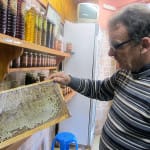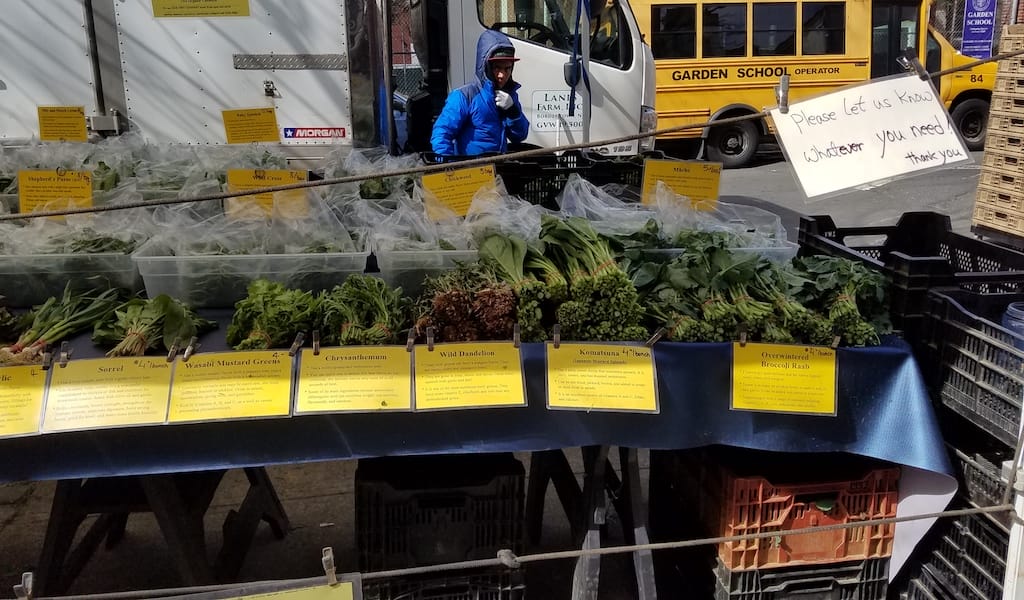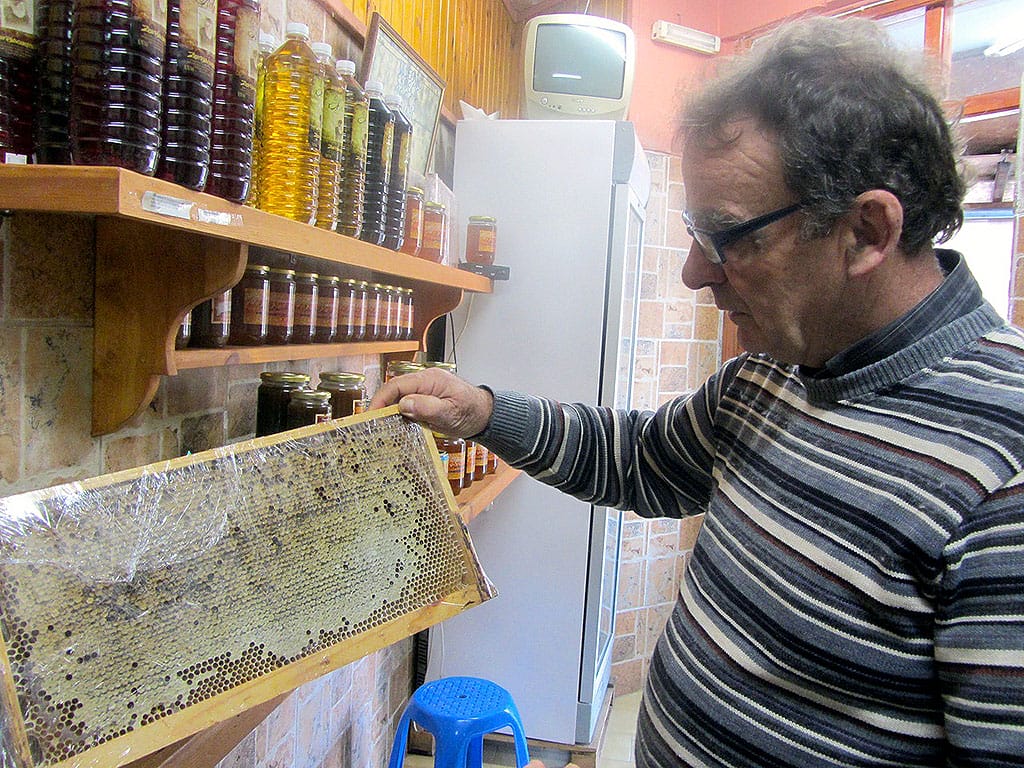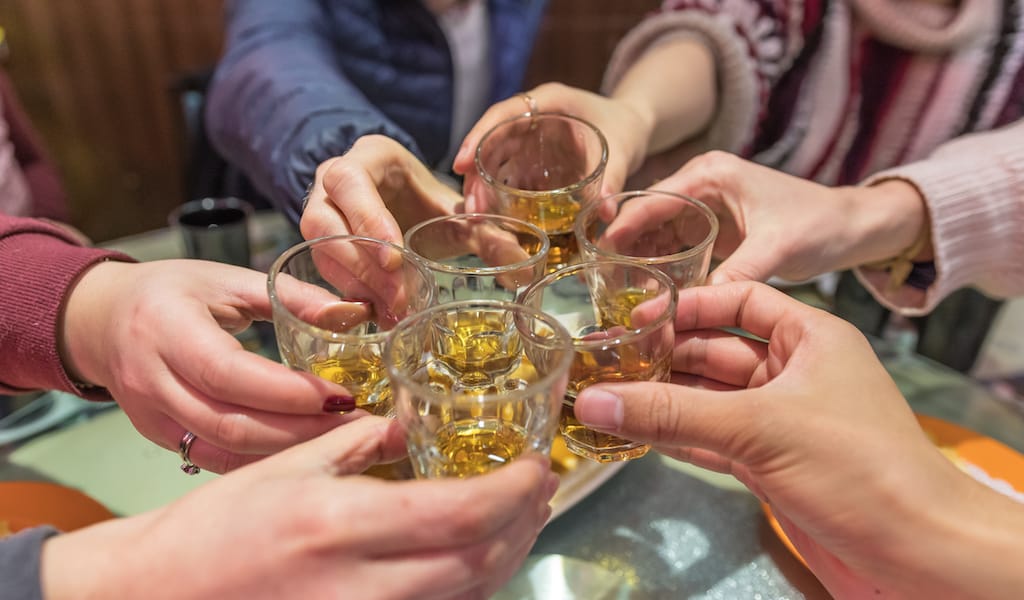In & Out arrived in Beijing years ago to rave reviews, but the Yunnan restaurant only just settled in Shanghai, confusing homesick Californians with its name. Instead of Double-Double burgers and Animal-Style fries, it serves cross-the-bridge noodles (过桥米线, guòqiáo mǐxiàn) and fried potato balls (土豆球, tǔdòu qiú).
While most Yunnan restaurants in China span the whole province’s cuisine, from tea leaf salads to crispy adzuki beans, In & Out’s menu is (mostly) specific to Lijiang, a city deemed a UNESCO heritage site that lies about halfway between Shangri-La and Kunming, the provincial capital, and is home to the Naxi and several other ethnic minorities. Lijiang cooks takes advantage of their location in the foothills of the Himalayas, foraging mountainous wild mushrooms and utilizing goat’s milk in cheese-making.
In & Out is a modern Chinese take on the ubiquitous mall restaurant: floor-to-ceiling windows, burnished cement floors and Naxi embroidery hanging from the gray brick walls. The waitstaff wear the traditional clothing of Yunnan’s local minorities, and plants sprout wildly from the walls and floors. The menu is beautifully shot, laid out like a coffee table book with stories and histories accompanying many of the dishes (in Chinese).
 When it comes to Yunnan food in Shanghai, you’d be hard-pressed to beat Lotus Eatery, but In & Out puts in a strong showing, and while it’s not destination dining, it is miles better than almost any other Chinese restaurant in the vicinity of Xintiandi’s touristy laneways. The typical Yunnan favorites, like fried goat’s cheese (乳饼, rǔ bǐng), are on the menu, but this is your chance to go a little more local, so try some off-the-eaten-path dishes like pan-fried tofu topped with chilies and green onions (石屏香煎包浆豆腐, shí píng xiāngjiān bāo jiāng dòufu) or eggs scrambled with edible jasmine flowers (茉莉花炒蛋, mòlìhuā chǎo dàn).
When it comes to Yunnan food in Shanghai, you’d be hard-pressed to beat Lotus Eatery, but In & Out puts in a strong showing, and while it’s not destination dining, it is miles better than almost any other Chinese restaurant in the vicinity of Xintiandi’s touristy laneways. The typical Yunnan favorites, like fried goat’s cheese (乳饼, rǔ bǐng), are on the menu, but this is your chance to go a little more local, so try some off-the-eaten-path dishes like pan-fried tofu topped with chilies and green onions (石屏香煎包浆豆腐, shí píng xiāngjiān bāo jiāng dòufu) or eggs scrambled with edible jasmine flowers (茉莉花炒蛋, mòlìhuā chǎo dàn).
Wash it all down with glasses of rice wine (米酒, mǐjiǔ). You can try white (白米酒, bái mǐjiǔ), funky in its fermentation, or purple (紫米酒, zǐ mǐjiǔ), almost cola-like in its syrupy flavor.
Save room for dessert. The offerings may not be traditional and they’re definitely not from Lijiang, but there’s plenty of mango and sticky rice puddings reminiscent of the Xishuangbanna region and its neighboring Thailand. We can’t resist a spoonful of the pineapple and mint “snow” (菠萝薄荷雪, bōluó bòhé xuě) topped with coconut cream – it’s like a Chinese piña colada.
 May 6, 2020 CB Pantry Raid
May 6, 2020 CB Pantry Raid
The next installment of CB Pantry Raid, a series in which our walk leaders give a guided […] Posted in Queens December 4, 2015 Building Blocks
December 4, 2015 Building Blocks
Editor's note: Our recurring feature, Building Blocks, focuses on foods and ingredients […] Posted in Athens March 4, 2019 “Warming” Yellow Wine in Shanghai
March 4, 2019 “Warming” Yellow Wine in Shanghai
Legend has it that huangjiu, or yellow wine, was invented by Du Kang, the god of Chinese […] Posted in Shanghai
Published on June 09, 2016
Related stories
May 6, 2020
Queens | By Culinary Backstreets
QueensThe next installment of CB Pantry Raid, a series in which our walk leaders give a guided tour of the local pantry, will take a slightly different approach. Esneider Arevalo, our lead guide in Queens, will be taking us with him as he visits the Jackson Heights Greenmarket, where New Yorkers can buy prepared pantry…
December 4, 2015
AthensEditor's note: Our recurring feature, Building Blocks, focuses on foods and ingredients that are fundamental to the cuisines we write about. This may come as a surprise, but little Greece is Europe’s fourth most important honey producer after Spain, Germany and Hungary. Every year, between 12,000 and 17,000 tons of this liquid gold are stolen…
March 4, 2019
ShanghaiLegend has it that huangjiu, or yellow wine, was invented by Du Kang, the god of Chinese alcohol. Because huangjiu is fermented, the Traditional Chinese Medicine (TCM) benefits of the drink are legion, and include “invigorating the blood.” You can see for yourself if that’s the case on our Night Eats tour in Shanghai.


















































































